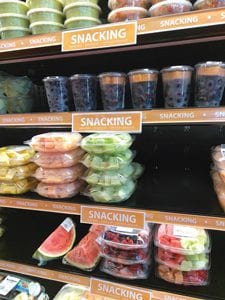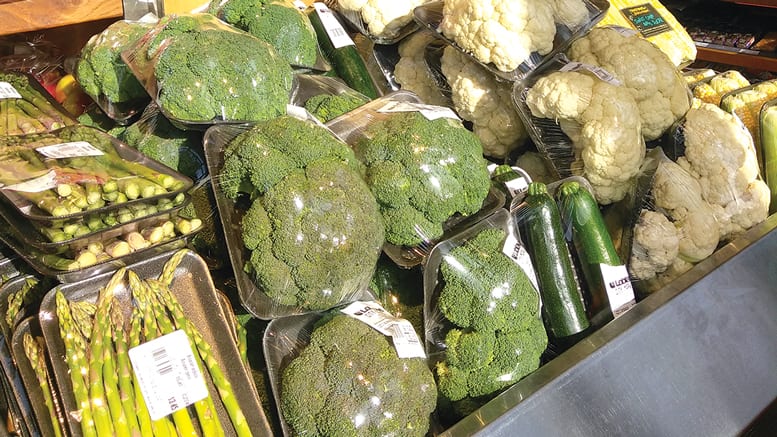Originally printed in the November 2018 issue of Produce Business.
Editor’s Note: This research was conducted exclusively for Produce Business to premiere at the New York Produce Show’s Ideation Fresh Foodservice Forum. More details on how the findings relate to different consumer demographics will be presented at the event on Dec. 13 at New York’s Midtown Hilton.
 There are few words more alluring to today’s consumers than “fresh.” Yet, the definition of fresh is just as elusive as the definition of healthy. Does fresh perception come from sourcing, merchandising or one of the other countless aspects of retail and foodservice operations? Culinary Visions set out to explore this topic in a survey of 1,500 consumers who were asked to share their opinions on the value of fresh food and the characteristics that define it.
There are few words more alluring to today’s consumers than “fresh.” Yet, the definition of fresh is just as elusive as the definition of healthy. Does fresh perception come from sourcing, merchandising or one of the other countless aspects of retail and foodservice operations? Culinary Visions set out to explore this topic in a survey of 1,500 consumers who were asked to share their opinions on the value of fresh food and the characteristics that define it.
Delving into what makes meals and ingredients fresh in the eyes of consumers debunks preconceived ideas and highlights opportunities for foodservice operators. Fresh foods come in different shapes, different channels, and different packaging, and consumers make their food-purchasing decisions based on experience and consumption habits that result in an incredibly flexible definition of “fresh.”
Fresh goes beyond organic labels, with only 50 percent of consumers considering organic food the freshest choice available. The facets of freshness push the boundaries of the produce section of supermarkets, with 65 percent of shoppers considering refrigerated prepared foods to taste fresh and 72 percent agreeing that refrigerated food with a re-sealable package is fresh. While fresh food is regarded as a treat by 81 percent of consumers, developing convenient, healthy and reasonably priced fresh meal concepts will answer the craving of consumers across all generations.
Fresh Sourcing
Locally sourced food is generally considered the freshest by all ages of consumers. In stores, 82 percent of Millennials, 83 percent of Gen X and 85 percent of Seniors believe locally sourced food is fresher than the alternative. Whether in a retail store or on a restaurant menu, it is not uncommon to find references made to local farmers responsible for bringing the food to the store or to the table. In restaurants, Millennials are the most likely to order menu items containing locally sourced ingredients at 82 percent, followed closely by Gen X at 80 percent and Seniors at 78 percent.
Fresh Value
Even in today’s fast-paced and time-starved world, fresh, flavorful food is often worth the wait. Eighty-six percent of consumers surveyed said they would be willing to wait for a customized sandwich rather than grab one and go, and only 34 percent said they would be willing to sacrifice flavor for convenience.
From in-store restaurants to special events in the produce department, consumers appreciate the value of a vegetable stir-fry or grilled vegetable assortment made for them with the produce department’s freshest ingredients of the day.
Fresh Snacking
As all-day snacking is becoming a prominent attribute in the modern consumer’s lifestyle, 65 percent surveyed said it is hard to find fresh snacks on the go. Sixty-nine percent said they don’t mind paying extra for healthy snacks, and almost half (46 percent) reported that they would skip snacking if they can’t find an option that is both convenient and fresh.
Consumers more than 55 years of age are the healthiest snackers, according to the survey. Even when on the go, 62 percent still care about the healthfulness of their snack, while younger consumers are more willing to sacrifice healthfulness when they are in a hurry — more than half of Gen X (53 percent) and Millennials (55 percent) let convenience rather than healthfulness drive their food choices when they are in a rush.
Millennials are most willing to pay a premium for conveniently packaged fresh snacks, with 82 percent saying they are likely to buy fresh, single-serving snacks, as opposed to 75 percent of Gen X and 68 percent of Seniors.
Merchandising Fresh
The terms “fresh,” “healthy” and “high quality” are often used interchangeably by consumers as desirable characteristics for meals both at home and away from home. In the search for these characteristics, consumers pick up a wide range of deciding cues from merchandising, store appearance, watching food preparation and interacting with service staff.
Connecting customers with the employees preparing their food builds the confidence and rapport that is important to customers — 79 percent of the consumers surveyed said they prefer food they can see being prepared. Display kitchens in restaurants, action stations in on-site foodservice operations and customized assembly in quick service restaurants are all meant to bring the kitchen up front and center stage for customers’ viewing pleasure.
Salad bars are popular with consumers, with 86 percent reporting that they enjoy getting food from them. However, when it comes to the fresh perception of salad bars, supermarkets have the edge, with a 75 percent consumer preference over both fast food salads (55 percent) and convenience store salads (32 percent) — as customers were asked how likely they would be to purchase salad in each venue.
Fresh perceptions translate to brand loyalty when consumers trust their local supermarket to pay attention to the details of sourcing and delivering the freshest food. Eighty-six percent of shoppers trust certain brands to be fresh, and supermarket brands enjoy far greater trust than global food brands.
Consumers relate supermarkets with freshness, which translates into an increased likelihood of someone purchasing a grab-and-go salad or sandwich from an on-site restaurant rather than picking up hot food from a convenience store. An additional incentive for consumers is when stores have separate quick checkout lanes for foodservice items. Packaging is another decisive freshness cue — 85 percent say transparent packaging is an important factor in determining freshness.
In-store execution also plays a prominent role in assessing the overall customer experience. Ninety-three percent agree that the cleanliness of the display is important in making purchasing decisions. The variety of offerings in large-format supermarket salad bars can feed the desires of customers making their meal at the salad bar, as well as those looking to make their home cooking fresher and more convenient by including salad bar ingredients. In discussions, some shoppers reported buying items including roasted peppers and pickled vegetables from the salad bar to make home-prepared meals easier without sacrificing flavor.
Experts On Staff Matter
 There is no dispute that a well-trained, customer-centric staff is important to any successful operation. This is particularly true when it comes to perceptions of freshness. Eighty-eight percent of consumers agreed that knowledgeable staff members are important in determining freshness. Customers also notice personal attention to cleanliness; with 93 percent saying that employees’ adherence to sanitation standards is crucial in determining freshness.
There is no dispute that a well-trained, customer-centric staff is important to any successful operation. This is particularly true when it comes to perceptions of freshness. Eighty-eight percent of consumers agreed that knowledgeable staff members are important in determining freshness. Customers also notice personal attention to cleanliness; with 93 percent saying that employees’ adherence to sanitation standards is crucial in determining freshness.
Millennial and Gen Z consumers can be the most unforgiving about lackluster service, choosing technology more than human interaction when they want to get their order right. This could mean using kiosks in foodservice operations to place customized orders exactly the way they want them or picking up grab-and-go items with self-checkout options.
When it comes to the supermarket, Millennials are the most likely generation to buy food from supermarket restaurants. Despite the recent boom in delivery services and their corresponding apps, Millennials are the most skeptical of delivered food of all the age groups surveyed. Fewer than half of Millennials surveyed (42 percent) agreed that delivered food is usually fresh, with Gen X consumers in the middle at 49 percent and Seniors shouldering the highest fresh delivery expectations at 63 percent.
Fresh Perceptions Translate To Brand Preference
Shopping for produce remains a very personal experience. Eighty-four percent of consumers surveyed like picking out their own produce, and the same percentage agrees that their local supermarket has great fresh food. Fresh perceptions translate to brand loyalty when consumers trust their local supermarket to pay attention to the details of sourcing and delivering the freshest food. Eighty-six percent of shoppers trust certain brands to be fresh, and supermarket brands enjoy far greater trust than global food brands.
The challenge is continuing to innovate with fresh offerings that appeal to loyal customers as restaurants, convenience stores, and other food venues continue to find new ways to capture the crave for fresh food.
Sharon Olson is the executive director of Culinary Visions, a division of Olson Communications based in Chicago. Culinary Visions is a food-focused insight and trend-forecasting firm that provides original consumer and culinary professional research for companies in the food industry.





